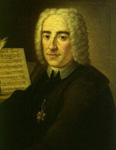Alessandro Scarlatti
(1660-1725)
 Alessandro Scarlatti is one of the most important Italian composers of the late Baroque period and is credited with establishing the Neapolitan school of opera and the Italian form of the opera overture. This format, allegro-adagio-allegro, became the forerunner of the classical symphony. Scarlatti was born Pietro Alessandro Giacomo Scarlatti on May 5, 1660 to Pietro Scarlata and Eleanor d’Armato in Palermo (at that time a part of Sicily) Italy. He was the 2nd of their 8 children. At 12 years of age he was sent to Rome to study under Giacomo Carissimi. Not much is documented about his school years except that his early work showed the apparent influence of Stradela and Legrenzi because of a connection with the style of Northern Italy. Scarlatti married Antonia Anzaloni in April of 1678. Together they had 10 children, 5 of whom survived to adulthood. He is the father of composers Domenico Scarlatti and Pietro Filippo Scarlatti.
Alessandro Scarlatti is one of the most important Italian composers of the late Baroque period and is credited with establishing the Neapolitan school of opera and the Italian form of the opera overture. This format, allegro-adagio-allegro, became the forerunner of the classical symphony. Scarlatti was born Pietro Alessandro Giacomo Scarlatti on May 5, 1660 to Pietro Scarlata and Eleanor d’Armato in Palermo (at that time a part of Sicily) Italy. He was the 2nd of their 8 children. At 12 years of age he was sent to Rome to study under Giacomo Carissimi. Not much is documented about his school years except that his early work showed the apparent influence of Stradela and Legrenzi because of a connection with the style of Northern Italy. Scarlatti married Antonia Anzaloni in April of 1678. Together they had 10 children, 5 of whom survived to adulthood. He is the father of composers Domenico Scarlatti and Pietro Filippo Scarlatti.
The first production of Scarlatti’s opera “Gli Equivoci nell Sembiante” in 1679 brought him to the attention of Christina, Queen of Sweden who at that time was in residence in Rome. The young composer, who was only 19, became her maestro di cappella. He held this position until February 1684 when he assumed the same position with the Viceroy of Naples possibly through the influence of his sister, an opera singer and courtesan. While serving in this position Scarlatti composed many operas as well as music for state functions.
Due to his objection to Spanish domination in the area, Scarlatti left Naples in 1702. He continued his work under the patronage of Fernando de Medici composing many operas for de Medici’s private theatre near Florence. Unfortunately, these scores have been lost. During this period he enjoyed the protection of Cardinal Ottobuni as his maestro di cappella and was quickly elected to the Arcadian Academy (Italian Literary Academy). Scarlatti also functioned as maestro di cappella for the Basilica de Santa Maria Maggiore in Rome before returning to Naples in 1723 where he went into semi-retirement.
Scarlatti’s music forms an important link between Baroque Italian vocal styles of the 17th century and the Classical school of the 18th century. He developed and used the ternary aria form. Although he did not write a great deal of orchestra music he placed greater emphasis on the string and wing instruments to accompany his vocalists. Scarlatti passed away in Naples on October 24, 1725.
Click below to view Alessandro Scarlatti titles:
t7t3l0uhl8|0010C39D6D07|DetailContent|contenttext|E576EA22-D758-4734-B737-3A002ABADEB0
<